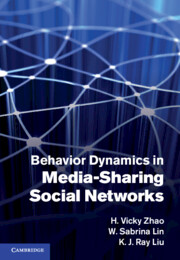Book contents
- Frontmatter
- Contents
- Preface
- Part I Introduction
- 1 Introduction to media-sharing social networks
- 2 Overview of multimedia fingerprinting
- 3 Overview of mesh-pull peer-to-peer video streaming
- 4 Game theory for social networks
- Part II Behavior forensics in media-sharing social networks
- Part III Fairness and cooperation stimulation
- Part IV Misbehaving user identification
- Part V Media-sharing social network structures
- References
- Index
2 - Overview of multimedia fingerprinting
from Part I - Introduction
Published online by Cambridge University Press: 28 April 2011
- Frontmatter
- Contents
- Preface
- Part I Introduction
- 1 Introduction to media-sharing social networks
- 2 Overview of multimedia fingerprinting
- 3 Overview of mesh-pull peer-to-peer video streaming
- 4 Game theory for social networks
- Part II Behavior forensics in media-sharing social networks
- Part III Fairness and cooperation stimulation
- Part IV Misbehaving user identification
- Part V Media-sharing social network structures
- References
- Index
Summary
During the past decade, increasingly advanced technologies have made it easier to compress, distribute, and store multimedia content. Multimedia standards, such as JPEG, MPEG, and H.26x, have been adopted internationally for various multimedia applications. Simultaneously, advances in wireless and networking technologies, along with a significant decrease in the cost for storage media, has led to the proliferation of multimedia data. This convergence of networking, computing, and multimedia technologies has collapsed the distance separating the ability to create content and the ability to consume content.
The alteration, repackaging, and redistribution of multimedia content pose a serious threat to both governmental security and commercial markets. The ability to securely and reliably exchange multimedia information is of strategic importance in fighting an unprecedented war against terrorism. A recent high-profile leak involved a classified video of Osama bin Laden's camp captured by an unmanned aerial surveillance vehicle, when one copy of the tapes shared between the Pentagon and CIA officials was leaked to the news media. Without effective traitor-tracing tools, different agencies would still be reluctant to share critical information, which jeopardizes the mission of fighting terrorism and defending national and global security. To prevent information from leaking out of an authorized circle, it is essential that the governments have the forensic capability to track and identify entities involved in unauthorized redistribution of multimedia information.
In addition to the demands from homeland security, preventing the leak of multimedia information is also crucial to the economy.
- Type
- Chapter
- Information
- Behavior Dynamics in Media-Sharing Social Networks , pp. 14 - 23Publisher: Cambridge University PressPrint publication year: 2011



